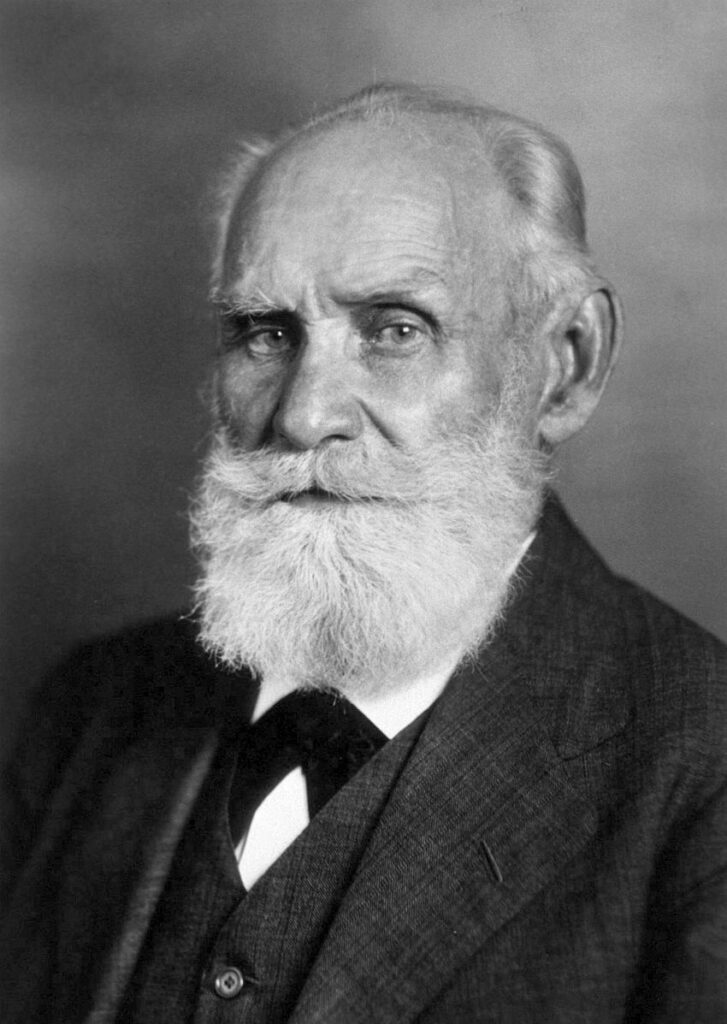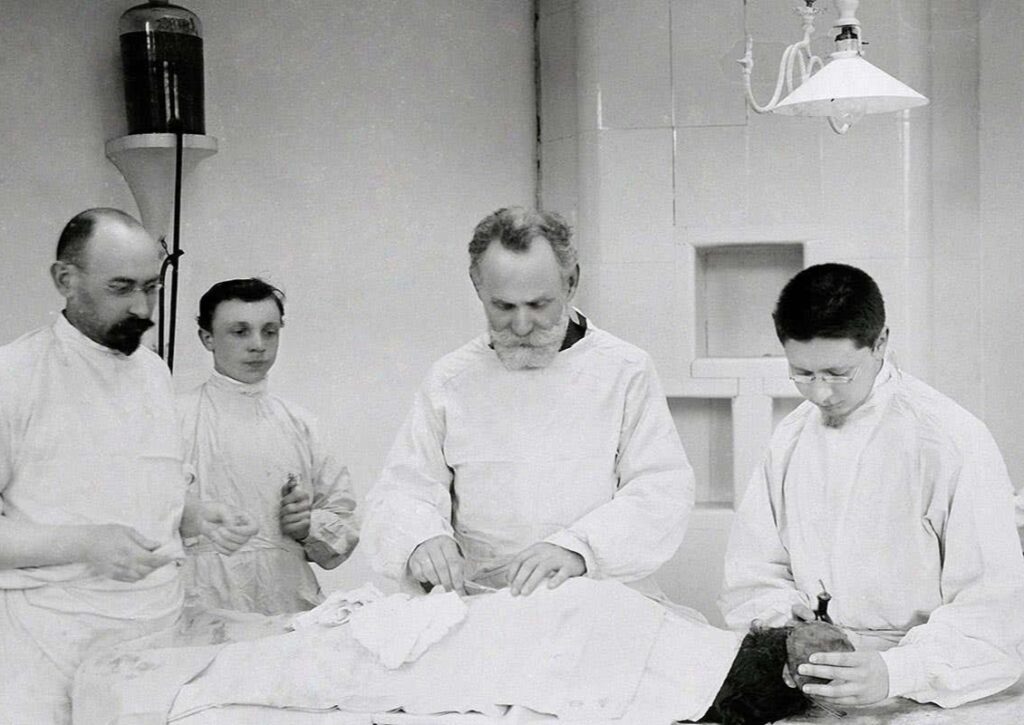In the realm of human psychology, few names stand out as prominently as Ivan Pavlov.
In the late 19th and early 20th centuries, Ivan Pavlov embarked on a scientific journey to understand conditioning and behavior. These experiments led to his discovery of classical conditioning represented by an infamous dog that would drool when a bell was rung.
But that is just a glossing over of the complex life of Ivan Pavlov. Pavlov’s experiments, while controversial, would revolutionize our understanding of learning and behavior.

Background on Ivan Pavlov
Ivan Petrovich Pavlov was born in Ryazan, Russia on September 26, 1849. The eldest of eleven children, he grew up in a deeply Russian Orthodox household.
Young Ivan initially aspired to become a priest like his father, enrolling in Ryazan Ecclesiastical Seminary. However, his intellectual curiosity soon led him away from the seminary and toward the world of science.
From his youth, Ivan Pavlov displayed a strong intellectual curiosity and a drive for research. Influenced by the progressive ideas of figures like Dmitry Pisarev and Ivan Sechenov, he turned away from a potential religious career to dedicate his life to science.
He enrolled in the University of St. Petersburg in 1870 where he pursued a degree in natural sciences, specifically in the fields of physiology and chemistry. As a student, Pavlov demonstrated his high intellectual prowess by winning a prestigious university award for his first research project.
As he continued to excel in his studies, his interest began to shift towards the realm of human psychology. He became fascinated with what made humans tick and what made them behave the way they do.
In 1875, Pavlov completed his course with an outstanding record and received the degree of Candidate of Natural Sciences. Impelled by his overwhelming interest in physiology, Pavlov decided to continue his studies at the Imperial Academy of Medical Surgery.
After some time, Pavlov obtained a position as a laboratory assistant at the physiological department of the Veterinary Institute.
Sometime in 1878 or 1879, Ivan met Seraphima Vasilievna, a student studying at St. Petersburg’s Pedagogical Institute. They were married on May 1, 1881. The first nine years of their marriage were difficult, marked by financial struggles, and drifting to various homes of friends and families.
Their first child, Mirchik, was born after a miscarriage, but his tragic death in childhood deeply affected Sara. The couple later had four more children: Vladimir, Victor, Vsevolod, and Vera.
Career in Physiology
After completing his doctorate, Pavlov went to Germany, where he studied in the Heidenhain laboratories in Breslau.
At the time, Heidenhain was deeply engrossed in the study of canine digestion. In Pavlov’s and Heidenhain’s experiments, a portion of the dog’s stomach was surgically brought outside of the body, allowing it to be exposed to the external environment. This procedure enabled them to directly observe and manipulate that specific part of the stomach.
Pavlov contributed to the experiment by addressing the challenge of maintaining the external nerve supply to the stomach. This innovation led to the designation of the exteriorized section as the Heidenhain-Pavlov pouch.

In 1886, Pavlov returned to Russia to look for something new to satisfy his curious mind. He was initially rejected for the position of Chair of Physiology at the University of Saint Petersburg.
But in 1891, Pavlov received an invitation from the Institute of Experimental Medicine in St. Petersburg to orchestrate and lead the Department of Physiology. It was here that Pavlov found his calling.
He led the department for over 45 years, making discoveries that would immortalize his name in the realm of science. It was during his time as director at the Institute of Experimental Medicine that Pavlov carried out his infamous experiments on the digestive glands, which would eventually land him the Nobel prize.
The Famous “Pavlov’s Dog” Experiment
Even people outside the academic world have heard of “Pavlov’s dog”. The name is actually a misnomer. The term oversimplifies an exhaustive series of experiments that took place over several years and with several different dogs.
While it is commonly believed that Pavlov only used a bell to signal food, his documented writings reveal that he employed a diverse array of stimuli. These stimuli encompassed electric shocks, whistles, metronomes, tuning forks, and various visual cues.
Pavlov’s research began as an investigation into the gastric functions of dogs by externalizing the salivary glands. This was a rather tortuous procedure for the dog as it involved drilling holes into the cheeks and having a small tube surgically inserted into the salivary gland.
As the study continued, Pavlov began to take notice of a peculiar phenomenon. He observed that the dogs began to salivate as soon as they saw the technician who fed them rather than salivate from seeing or smelling the food.
He called this strange phenomenon “psychic secretion.” He began to dedicate his time to understanding conditioning and its impact on learning and behavior.
The experiments began by placing a dog in a controlled environment, typically a soundproof and odorless chamber, to eliminate any external influences. The dog was surgically prepared so that Pavlov could measure its salivation rates.
Pavlov learned that if a buzzer or bell sounded before the food was given, the dog would learn to associate that sound with food and begin to salivate in anticipation. This demonstrated that the dog had learned to associate the bell with the impending arrival of food.
This meant that new neural pathways could be formed through repeated associations. This allowed organisms to acquire and adapt to novel behaviors based on environmental cues and stimuli.
This experiment not only revealed the concept of classical conditioning but also established that learned behaviors can be elicited by previously neutral stimuli. The implications of this experiment were far-reaching and it netted Pavlov the Nobel Prize in 1901 in recognition of his significant work on the physiology of digestion, particularly his research on the digestive gland.
Theoretical Implications
Ivan Pavlov’s discovery of classical conditioning was a groundbreaking moment that emphasized, if not proved, that environmental factors can drastically influence behavior. This challenged long-held notions that behavior was solely a product of innate characteristics.
Pavlov’s research laid the foundation for the study of associative learning, a cornerstone of psychological theory. It established a model for further exploration and research into how organisms acquire new behaviors and adapt to their environments.
Pavlov’s work aligned seamlessly with the emerging school of thought known as behaviorism. Pioneered by figures like John B. Watson and B.F. Skinner, behaviorism emphasized the study of observable behaviors and the influence of environmental stimuli.
Pavlov’s demonstration of classical conditioning provided empirical support for the principles of behaviorism. It illustrated how responses could be reliably shaped and predicted through the establishment of associative links with stimuli.
Controversies Surrounding Experiments
During Pavlov’s era, ethical standards regarding animal experimentation were not as well-established or regulated as they are today.
The welfare of laboratory animals was not a major concern during a time when most people were struggling for their survival. Pavlov’s experiments on dogs, which involved surgical procedures, restraint, and sometimes invasive measures, would not go over well with audiences today.
Several of his experiments did not involve positive reinforcement, but rather negative reinforcement techniques. These included measures such as flooding the dogs’ kennels and inducing a sense of impending drowning, as well as pushing dogs down flights of stairs to condition them to be afraid of steps.
Pavlov’s hunger for knowledge didn’t end there. He also conducted similar procedures on orphaned or homeless children.
These children, like the dogs, underwent surgical procedures to attach spigots to their cheeks, and they were restrained with a mechanism leading directly to their mouths. Pavlov would ring a bell and release a cookie or biscuit down the mechanism, which would then be delivered into the child’s mouth.
In retrospect, Ivan Pavlov’s experiments would be seen as unethical and inhumane by today’s standards. Despite the unethical treatment of his subjects, his experiments played a pivotal role in advancing our understanding of learning, behavior, and the physiological processes underlying them.
The principles of classical conditioning pioneered by Pavlov continue to have a profound impact on psychology and related fields. These discoveries have not only deepened our knowledge of human and animal behavior but also led to the development of modern therapy for conditions such as phobias and anxiety disorders.
Pavlov’s Legacy
Pavlov’s work might be ethically questionable by contemporary standards but they have significantly advanced our understanding of learning and behavior.
His findings laid the groundwork for behaviorism and influenced generations of psychologists. His work on associative learning continues to inform research on cognitive processes, human behavior, and clinical psychology.
In his later years, he recognized the ethical concerns surrounding animal experimentation and advocated for improved animal welfare in scientific research.
References
Ivan Pavlov’s Experiments on Men. Archive film 97453
https://www.youtube.com/watch?v=WLFZ4N9ZaE4&ab_channel=HuntleyFilmArchives
Ivan Pavlov
https://en.wikipedia.org/wiki/Ivan_Pavlov#Legacy
Ivan Pavlov and His Discovery of Classical Conditioning
https://www.verywellmind.com/ivan-pavlov-biography-1849-1936-2795548

